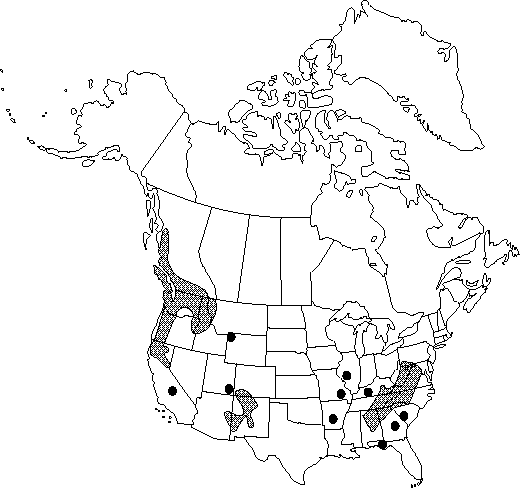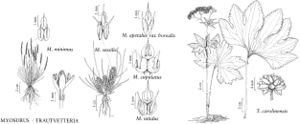Trautvetteria caroliniensis
Mem. Torrey Bot. Club 2: 42. 1890.
Herbs, 0.5-1.5 m. Rhizome with fascicles of fibrous roots. Stems 1-several, erect, usually unbranched below inflorescence, 0.5-1.5 m, glabrous or glabrate. Leaves: basal leaves with petiole to 4.5dm, blade 1-3(-4) dm wide, lobe apex acute; cauline leaves reduced toward apex of stem. Inflorescences: peduncle 1-8dm; pedicel densely pubescent with minute, hooked trichomes. Flowers: stamens white, 5-10 mm. Utricles papery, veins prominent along angles and on 2 adaxial faces. 2n=16.
Phenology: Flowering summer.
Habitat: Wooded seepage slopes, stream banks, bogs, rarely prairies or bluffs, western spruce-fir forests and subalpine meadows
Elevation: 0-3800 m
Distribution

B.C., Ala., Ariz., Ark., Calif., Colo., Fla., Ga., Idaho, Ill., Ky., Md., Mo., Mont., N.Mex., N.C., Oreg., Pa., S.C., Tenn., Utah, Va., Wash., W.Va., Wyo., Mexico, e Asia.
Discussion
Trautvetteria caroliniensis apparently has been extirpated from Indiana.
The numerous white stamens make Trautvetteria caroliniensis an attractive ornamental, and it is reportedly easy to grow.
Populations of Trautvetteria caroliniensis in western North America have been distinguished from the eastern typical material as T. caroliniansis var. borealis (Hara) T. Shimizu [synonym: T. caroliniensis var. occidentalis (A. Gray) C.L. Hitchcock]. Asian populations, long treated as the distinct species T. japonica Siebold & Zuccarini, were most recently regarded (T. Shimizu 1981; M. Tamura 1991) as conspecific with the North American populations [as T. caroliniensis var. japonica (Siebold & Zuccarini) T. Shimizu]. Aside from geography, varietal differences seem rather arbitrary.
The Bella Coola applied poultices made from the pounded roots of Trautvetteria caroliniensis to boils (on adults only) (D.E. Moerman 1986).
Selected References
None.
